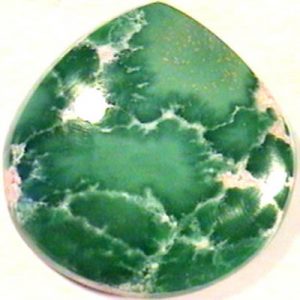Variscite
Variscite as crystals is very rare and minute. The massive form or as nodules are fairly common and are used for cabochons and carving. It is a secondary mineral formed by direct deposition from phosphate-bearing water that has reacted with aluminium-rich rocks in a near-surface environment. The variscite crystal habit is Uncommon as crystals, then pseudo-octahedral may be lathlike; modified by numerous smaller forms, to 1.5 mm. Usually fine-grained massive, in nodules, stalactites, crusts, and veinlets. It occurs as fine-grained masses in nodules, cavity fillings, and crusts. Variscite often contains white veins of the calcium aluminium phosphate mineral crandallite. The lime green material from Utah is particularly attractive with its interesting patterns and swirls of bright green colors.
| Category: | Phosphate minerals |
| Formula: | AlPO4·2H2O |
| Hydrated aluminium phosphate mineral | |
| Crystallography: | Orthorhombic – Dipyramidal |
| Crystal Habit: | Uncommon as crystals, then pseudo-octahedral, may be lathlike; modified by numerous smaller forms, to 1.5 mm. Usually fine-grained massive, in nodules, stalactites, crusts, and veinlets. |
| Cleavage: | [010] Good; [001] Poor |
| Fracture: | Uneven to splintery, conchoidal when glassy |
| Tenacity: | Brittle |
| Moh’s Hardness: | 3.5 – 4.5 |
| Density: | 2.20 – 2.61 (g/cm3) |
| Radioactivity: | Not Radioactive |
| Color: | Green, blue green, yellow green and rarely red |
| Luster: | Vitreous to waxy |
| Refractive Index: | nα = 1.563 nβ = 1.588 nγ = 1.594 Biaxial (-) |
| Birefringence: | 0.031 |


